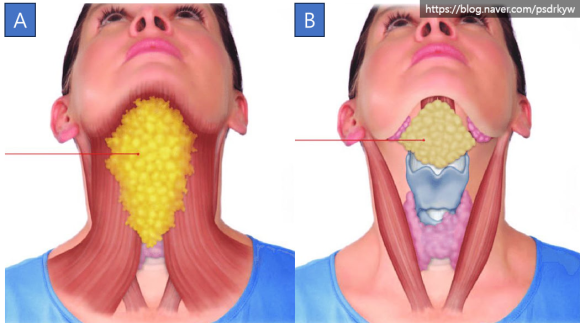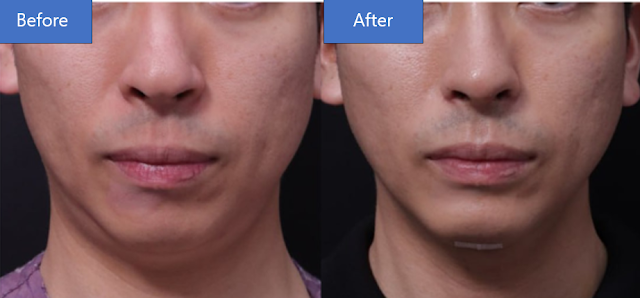Best Double Chin Surgery: Liposuction, Platysma Plication, Neck Lift Everything You Need to Know
Hello, I’m Dr. Yongwoo Kim, plastic surgeon at Dr. Returning Plastic Surgery.
In today’s post, we’ll dive deep into the
topic of double chin surgery. While it can be a bit complex, this guide
will give you a full understanding of double chin causes and the appropriate
surgical solutions.
What Causes a Double Chin?
Double chins may be genetic, but in most
cases, they become more pronounced with age. The treatment method depends on
the cause, and simply removing fat with liposuction is not always effective. In
fact, many patients come to me after failed liposuction procedures performed
elsewhere.
Since each surgeon’s diagnosis and approach
can vary, it’s important to understand the underlying anatomical causes. This
ensures the surgery is customized to your needs and yields a satisfying result.
The Ideal Neckline
 |
| [Image Source: Neligan vol. 2] Ideal youthful neckline Defined jawline 2. Cervicomental angle of 105° 3. Anterior border of the sternocleidomastoid muscle |
Textbook ideal neck features include:
- A defined jawline
- A cervicomental angle of 105°–120°
- Clear outline of the sternocleidomastoid muscle
As we gain weight or age, the neckline
starts to sag and deviate from this ideal. The solution? Choosing the right
surgical method for the specific anatomical problem.
Double Chin Causes and Corresponding
Treatments
The neck anatomy can be divided into three
layers:
- Skin and subcutaneous fat
- Platysma and supraplatysmal fat
- Deep fat and muscles/glands
Through physical exam and ultrasound, we
can determine the exact cause of a patient’s double chin and design a
personalized surgical plan.
 |
| Ultrasound examination can identify the anatomical structures causing a double chin |
Liposuction + Platysma Plication
 |
| [Image Source: Neligan vol. 2] Platysmaplasty |
Platysma plication is one of the most
common procedures for double chin correction. Through a 2 cm incision under the
chin, excess fat is removed, and the loose platysma muscle is tightened to
improve sagging soft tissue.
However, not all fat in the double chin can
be removed with liposuction alone. There are two specific fat compartments —
supraplatysmal (on top of the platysma) and subplatysmal (beneath the muscle) —
that require direct surgical excision.
 |
| [Image Source: PRS Global Open, 2016] A: Supraplatysmal fat B: Subplatysmal fat |
If liposuction doesn’t work, it may be
because these deeper fat pads were not removed. Ultrasound before surgery helps
identify whether excision is needed.
Neck Lift (Face/Neck Lift) vs. Thread
Lift
Liposuction and platysma plication alone
can improve many cases, but when moderate to severe skin laxity is present,
skin must be physically excised. This cannot be done through a submental
incision — instead, excess skin must be lifted and removed through a facelift
or neck lift approach from around the ears.
For long-lasting results, a deep plane
dissection must be performed. This involves lifting the SMAS and platysma
layers, releasing retaining ligaments, and repositioning the tissues — not just
trimming excess skin. This also reduces risks like visible scars or pixie ear
deformity.
If skin sagging is mild, thread lifting may
be used to create adhesion and elevate the tissues with a hammock-like effect.
Submandibular Gland Reduction
 |
| Enlarged submandibular gland sagging under the jaw |
If a bulge under the jawline is caused by
an enlarged submandibular gland, it won’t improve without gland reduction.
Botox may help temporarily, but surgical reduction is often necessary. This
procedure requires caution to avoid bleeding or nerve injury.
 |
| Submandibular gland being excised below the platysma |
Chin Advancement & Implants
In patients with a receding chin
(microgenia), deeper muscles like the digastric tend to sag, worsening the
double chin. Since the digastric muscle attaches to both the hyoid bone and
chin, a short distance between these points in receding chin cases leads to
drooping.
Chin advancement surgery or silicone chin
implants can correct this.
 |
| Muscle sagging due to microgenia — corrected with chin advancement or implant |
Surgical Case Examples
Case 1: Platysma Plication + Neck Lift
Revision + Pixie Ear Correction
- Female, 50s
- Skin (++), Subcutaneous Fat (–), Platysma Laxity (++),
Supraplatysmal Fat (+)
The patient had previous liposuction and
facelift elsewhere, but no proper SMAS dissection was performed. The platysma
sagged again, and a pixie ear deformity developed. Revision neck lift using
deep plane technique and platysma plication was done without liposuction.
Case 2: Liposuction + Neck Lift
- Female, 40s, Caucasian
- Skin (++), Fat (++), Platysma Laxity (+), Supraplatysmal Fat
(–)
Due to thinner skin and faster aging,
Caucasian patients often need skin excision. In this case, ultrasound showed
thick subcutaneous fat but little platysmal fat. Liposuction and neck lift
without platysma work yielded great results.
Case 3: Liposuction + Platysma Plication
- Male, 40s, Caucasian
- Skin (++), Fat (++), Platysma Laxity (++), Supraplatysmal Fat
(++)
Surgery was recommended: liposuction,
platysma plication, and neck lift. The patient refused the neck lift, so the
jawline remained less defined due to unresolved skin laxity.
Case 4: Liposuction + Platysma Plication
+ Neck Lift
- Female, 50s, Caucasian
- Skin (++), Fat (++), Platysma Laxity (++), Supraplatysmal Fat
(++)
Same diagnosis as the previous male
patient, but all procedures were performed — including facelift. Result:
significantly sharper neck contour.
Case 5: Platysma Plication + Neck Lift
(with Mint Threads) + Chin Implant
- Male, 30s
- Skin (+), Fat (–), Platysma Laxity (++), Supraplatysmal Fat
(++), Microgenia (++))
This patient had both platysma laxity and a
weak chin, leading to muscle drooping. Through a submental incision, both
platysma plication and chin implant placement were performed for a defined neck
angle.
Conclusion
We’ve reviewed the causes and surgical
solutions for double chin correction. Though the anatomy may seem complex,
having this knowledge helps you choose the right surgeon and get the right
procedure.
I hope everyone reading this finds success
in their journey toward a sharper jawline.
Thank you for reading.
— Dr. Yongwoo Kim
#DoubleChinSurgery #SubmentalLipo #PlatysmaPlication #NeckLift
#ChinImplant #KoreanPlasticSurgery #DrReturning #JawlineSculpting
#FacialRejuvenation #BeforeAfter














Comments
Post a Comment